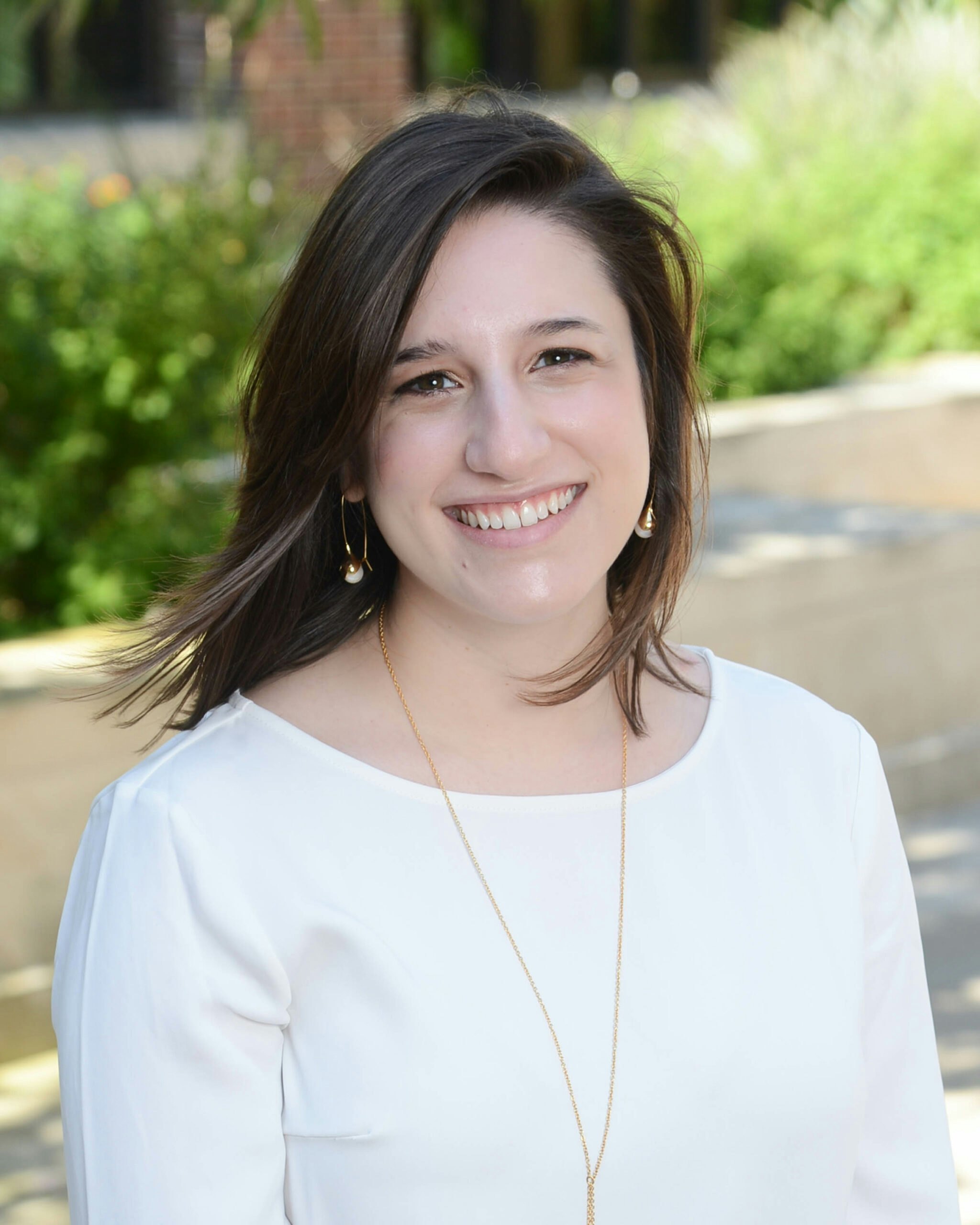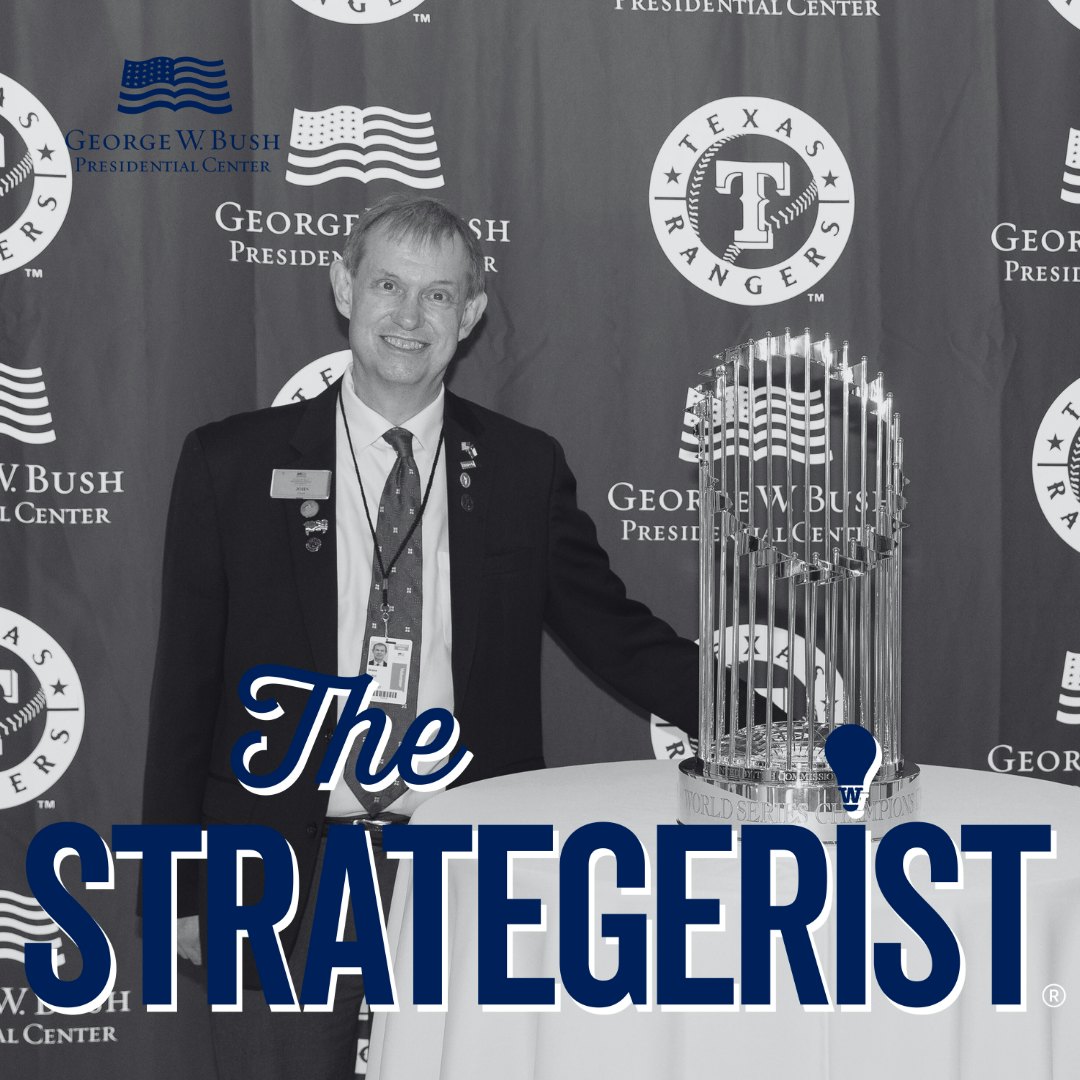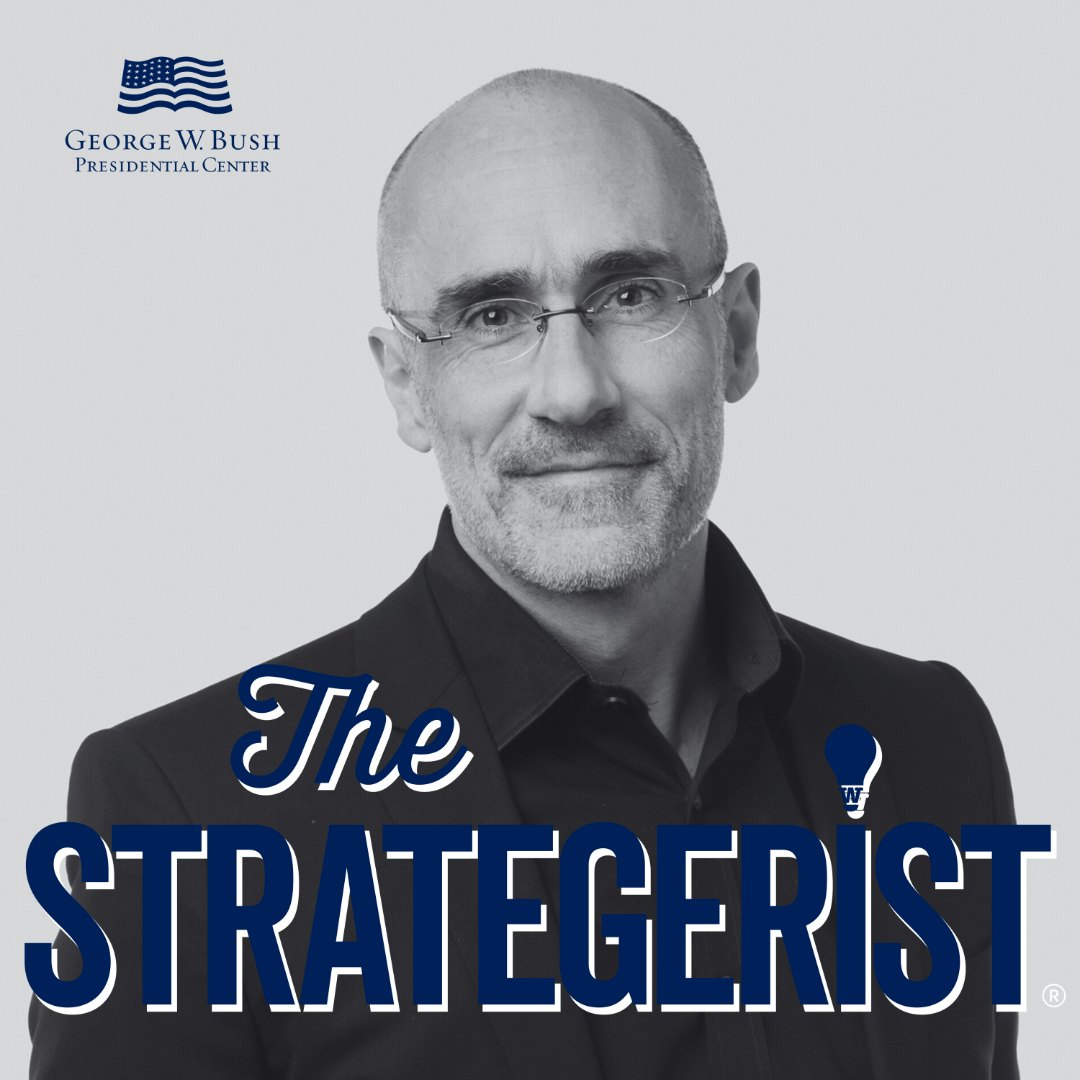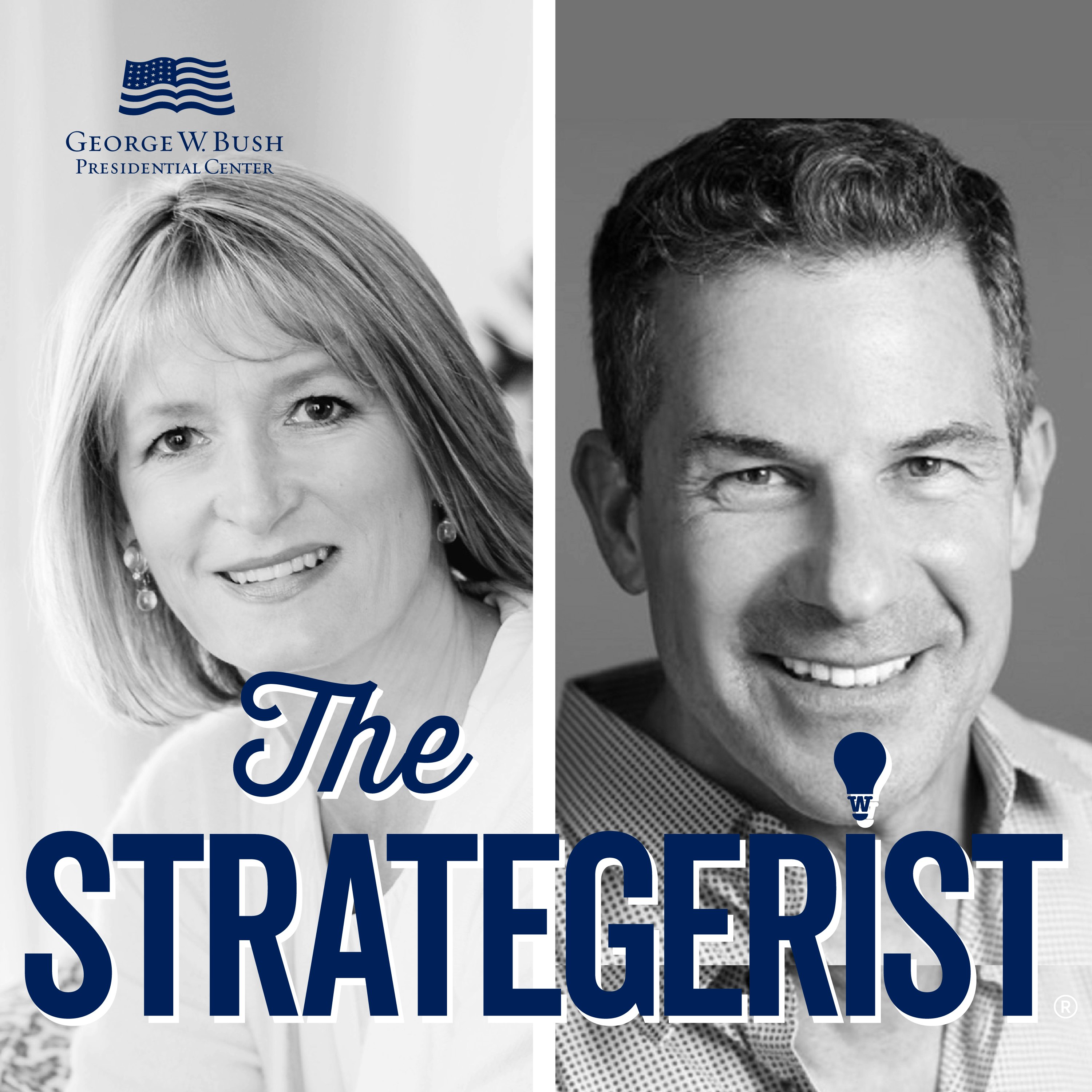The conservationist, interior designer and best-selling author is saving the world one plant at a time. We chat robotic bees, the beauty of native plants, and life as a business owner.
James Farmer is an expert conservationist, interior designer and best-selling author who is saving the world one plant at a time. We chat about robotic bees, the beauty of native plants, and life as a business owner. And he also throws in some gardening tips.
RelatedCONTENT
-
- Interested in hearing more from James? Check out a conversation on conservation at the George W. Bush Center’s Forum on Leadership in April 2018,.
-
- The Bush Center’s Native Texas Park is open from sunup to sundown 365 days a year — and pets are welcome.
Read the episode transcript
Transcript
01:08 Andrew Kaufmann (AK): Well, I am very excited to welcome James Farmer to the show. James, thank you so much for joining us.
01:13 James Farmer (JF): Thank you Andrew, for having me.
01:15 AK: So James, you were one of the featured speakers at the inaugural forum on leadership at the Bush Center last year, alongside people like Bono and Secretary Condoleezza Rice and Jeff Bezos. But when the dust had settled, in the days after the event, the buzz around the Bush Center offices was on gardening and conservation and James Farmer.
[chuckle]
01:35 JF: Y’all, really must not have anything else to talk about. But I’m flattered, thank you. [chuckle]
01:40 AK: Well, you had a great session and we want to continue that conversation here today, but before we get into gardening tips, and we will get to gardening tips for all you aspiring green thumbs out there, we want to start at a broader level. Why is it important that cities both big and small find ways to create beautiful green spaces and community gardens?
02:00 JF: Well, I don’t think the size of the city really matters but the size of the green space is what really truly affects us. So you could use my hometown, which is Perry, Georgia or you could use Dallas or New York, no matter what a green space truly affects us. And in that sense, I always refer back to what my grandmother had talked about when she was setting a table and that was, “We eat with our eyes first.” And so anyone who talks to me knows that this is the mantra that I live by; before we take that first bite, there’s a visual feast. So it may be a tomato sandwich, but that tomato started somewhere. So, it’s looking out and seeing some kind of greenery that starts the feast, that starts the meal, that starts the event. So in a city, especially where you have a lot of hardscape, it’s so nice and refreshing to have a place of rejuvenation that’s green and that could be a pot on your balcony that has some mint. And I always tell people, “If you can’t grow a pot of mint. Well, I don’t know if we even have hope,” but the pot of mint, what it is…
03:03 AK: That might be me.
03:05 JF: That might be but Andrew I guarantee you, I can get you to grow some mint. But what I love about that is this, you look outside and if you’re surrounded by harder things, your concrete, steel, glass, things like that, the softening aspect, that visual feast, that eating with our eyes first, that green provides, really starts working on our psyche in a very good way. And to look at that pot of mint or it could be basil or some other herb, to look at that pot of mint and think, “You know what, I can just look at that and immediately my blood pressure goes down.” I can think of all the studies that think about hospitals and nursing and rehabilitation places that where green really is so important in those places. So it’s just as important in a big city. Think about that sprig of mint, I could put it in some warm tea and I’ve got a delicious beverage. I could take it and, hey, make it even more of a libation or a spirited beverage like a mint julep. Or that pot of basil, you could take just that one leaf and put it with that tomato sandwich and maybe you’ve grown that tomato too.
So there’s a whole cascading effect of how green really affects our psyche, on a small level, like a little small pot. But think about what it does when it gets grown into a larger area, like a park, and how a park or a strip of wild flowers between the north and south bound lanes of the interstate. Or maybe it’s just the preservation of some native trees or grasses, it allows our eyes to see a rest, a respite, and it starts rejuvenating. So it goes back to that, “We eat with our eyes first.” I’ve learned that from my grandmother and I think that’s applicable for a table setting, I think it’s applicable for a big city and a park or even your backyard.
04:44 AK: On the topic of preservation, we’ve tried to do just that at the Bush Center, we sit next to a 15-acre park that restores the land to what it might have looked like before the City of Dallas arrived. It’s filled with native trees and flowers and plants and grasses. Are you seeing more of these projects in other cities or do we still have a long way to go before making a large impact?
05:07 JF: We do have a long way to go, but to answer that first question, I am seeing it and I’m fortunate enough that with my books and my design business, I do get to travel and that’s one of the first things that I look at. I touch down, I could be in Oklahoma City or I may be in Roanoke, Virginia, or Santa Barbara wherever the place is that I land, the first thing that I look for is, “What are they doing here, to give back to nature, to the town, to the environment?” And part of that is that exciting green space. I love what y’all done at the Bush Library and the Bush Center because you give right back to that Texas wild flower, that Texas field and what it does is it sets the tone. We’re fortunate enough that we can bring in orchids from Hawaii or roses from south Texas or wherever and put together amazing flower arrangements in a hotel lobby. But there’s still something pretty authentic and amazing about having something that has been there since time began, and having those wild flowers and those native greeneries around really, really do, not only a favor to the environment, but they give back to that psychological effect that a green space truly has.
06:13 AK: So you said we still have a long way to go, are you worried about the planet? I was just reading a story recently about bee shortages, and how there’s not enough of them to do the vital job of pollinating plants, and the story suggested that robot bees can help, which to me sounds like the plot of a horror movie but it’s out there as a possible solution, as a man that is one with nature are you worried?
06:35 JF: I am worried and the worry is this… I’m gonna answer your question with a question. Did you have a glass of orange juice this morning or coffee? Did you have some berries with your yogurt? If you have eaten any fruit in the last 24 hours, you can thank a bee. And I think the first key to really any problem to begin any solution is knowledge, is that information of how do we tell people bees really do affect our daily life. You may not think about it as you were pouring those strawberries over your cereal this morning but those strawberries were pollinated somehow, and the bees and those pollinating insects are what are doing that. I think it’s fantastic that we have technology that can help us but the original tried and true method of that pollination with the bees is incredible.
So it’s a big daunting task to think about the environment and any solution of how to fix it. I think the first and foremost thing to do is to inform people, to let them know, “You know what, bees do pollinate our fruits and vegetables,” or to think, “You know what, it really is amazing that saving this much water or this much gasoline,” or whatever it is. If one person does it, then a dozen people do it and then a couple dozen that really can truly have an amazing effect. So it all goes back to me, and growing up and the way that I grew up, is that we are what we eat, we are what we drink, and that there are awesome things that can be done to help preserve and protect, but knowledge and that information truly, truly, is key.
08:03 AK: For the city dwellers with small yards or even no yards, you mentioned growing some mint or some herbs, what else can we do as individuals to make this a better planet to live on?
08:12 JF: Well, I always like to have something that says, “Welcome home.” It could be two pots by your front door with ferns in them, it could be a collection of a couple of containers on your balcony. It might even be that one great house plant that says, “Welcome home,” because there’s something about greenery, about flowers, whether it’s a hotel lobby or the entrance to a golf course or a museum or wherever you go, the first thing that you see are… There’s landscaping, it’s the flowers. So I love to create “welcome home” moments for clients. Those may be those pots at the front door, it may be the fresh flowers inside. So if you don’t really have a big yard, then what I like to do is encourage people to think about inside things. Maybe it’s just picking up a bunch of flowers at the farmer’s market each time and putting them in a mason jar or a pretty vase and maybe that’s the one thing you do but if it creates this visual component of beauty. The two urns or pots or containers by your front door that just say, “Welcome home Andrew,” it’s just something about that. And they’ll remind you, that if you haven’t watered them they’ll wilt.
09:15 AK: Well they’ll say, “Welcome home,” until I give them too much water or not enough water and kind of fall apart from there.
09:22 JF: But remember, knowledge is key. So when you know how to water something and how to take care of it, it’ll reward you.
09:29 AK: What two plants do you have on your doorstep? And what are your welcome home plants?
09:33 JF: Well, right now I have some bamboo palm that are in terracotta pots and I plant them usually around Easter weekend and they go almost all the way to Christmas, so I really get a big bang for my buck, with those. They’re green, for most of the year, and then I take ’em out and I store ’em for the winter time, and then during the winter time I put something like… That’s evergreen, like a camellia or a rosemary or some kind of conifer topiary and that’s my welcome home. I definitely practice what I preach. You will know what season it is if you look at my steps, I always have something on them to say, “Welcome home, welcome to Farmdale, my home, and welcome to the season.”
10:15 AK: James, you call yourself a lazy gardener. What do you mean by that?
10:17 JF: Well, I am truly the laziest gardener of all because there’s so much else that I need to do.
10:22 AK: You haven’t met me.
10:23 JF: Yeah, I haven’t met you. Okay so maybe I’m the second laziest gardener behind you. [chuckle] But the reason I call myself a lazy gardener is this, I get distracted. As soon as I pull one weed, I see a stick that needs to be picked up, as soon as I pick up one stick, I see something else that needs to be done. And there’s this compound of things, of other things that I need to do where I pull out my phone, I check out Instagram or I think, “Oh, I really want to read this blog about humming birds.” So I don’t know how lazy it is or how distracted that I am as a gardener, but I’m also one of these people that I believe this bodes well for my business as well as to hire your weakness. And so, if I’m not really good in the full sun all day long, guess what? Lantana is, succulents are, there are some other plants that love the full sun and will grow and do amazing. So rather than taking something that is precious and dainty and needs gallons and gallons of water, I plant something that will thrive and survive and do the work for me. So then people say, “James, your lantana looks amazing,” and I just kind of grin and think, “Oh, thanks so much.” All I did was plant it and get it started. So that’s the lazy gardener in me, I let another plant do the work for me and it makes me look better than I really am.
11:31 AK: And that’s key for conservation too. You wouldn’t want to put a water thirsty plant in an area without much rainfall, right?
11:38 JF: Exactly, so that lazy gardener’s kind of a fun catchphrase, however it catches people, it hooks ’em in, and they think, “Oh, I can be a lazy gardener.” Well, sure, it is going to require some work but you put the right things in the right place and they’ll reward you.
11:53 AK: How did you develop such a love for gardening?
11:55 JF: I really think it came from my grandparents on both sides. My grandfather Farmer had a small nursery and I think Farmer’s Nursery people just thought, “Well, his name alone, he knows what to do.” So that was one aspect that I think I got from him and then my mother’s parents, the Grenades, they have always instilled in me, whether it was the love of fresh flowers and fruits and vegetables from my grandmother and knowing what was in season. People think, “Okay, it’s peach season.” Do you know how many varieties of peaches there are? My grandmother knew it down to the week, she would say, “In this week, the July Prince are perfectly ripe or the Elbertas,” or whatever it is. And my grandfather always has kept a vegetable garden. So knowing that that tomato that’s grown in the backyard… In the Deep South, what we do is we grow flowers and vegetables in a garden but the yard is for all the other plants that’s that southern nomenclature there for you. Though granddaddy would grow squash, and tomato, and okra, and zucchini and things like that and we would harvest them. And I was mesmerized as a child that I could go outside and pick something and then we would eat it, and that combination and that symbiosis of knowing where something started and where it came from and how it became our food was fascinating to me. So I caught the gardening gene real early.
13:15 AK: Well, it couldn’t be more fitting with your name.
13:16 JF: I know, people ask me all the time, if I’ve made up my name to write gardening and design books. I thought, “No, it was just given to me, it’s the best nom de plume ever bestowed.”
[chuckle]
13:26 AK: So speaking of those books, you’re the author of seven, the most recent one being A Place to Call Home. It sounds like you’re living the dream, and that you’ve been able to turn your passion into a business. How did you pull that off?
13:37 JF: Well, I was asked a very interesting question very recently and someone said, “Did you always know this is what you wanted to do?” I looked at them and without any hesitancy, I said, “Yes.” I knew that what I wanted to do involved design and how we live and the lifestyle that I feel like the South has such a great hallmark on. So I went to college for design, I studied at Auburn University, I studied landscape design and art history and that led into the interior design and then the garden design business. But I’ve always known that and to me, that’s one of the biggest blessings and gifts that any person can have, and that is to know exactly what they want to do. Fortunately for me, I found that out early on so I spearheaded my ideas and knew that I could, one, make money by helping people with their homes, but I also knew that I never would have to work a day in my life because my work was so much fun. So that really became a true blessing that I really reflect on and very grateful for each and every day.
The books have been an amazing segue because I can do interviews with folks and write for magazines but the books really give you a great bit of street cred in the sense that I like to practice what I preach and I like to write about it, and I like to share it from a platform like books. I’m still an old fashion so I love books; I love to hold them, I love to read them, I love to turn the pages. And thankfully, other people do too.
15:04 AK: And as a budding entrepreneur, what are some of the most important lessons that you learned early on?
15:10 JF: One of the most important lessons, and I mentioned it earlier, and I think it’s so worth harping on, is to hire your weakness. Andrew, if you want me to tell you how to make your house beautiful, I’ve got that all day long. But if you want me to file your taxes, I’m the last person that needs to do that. So I realize early on if you hire your weakness, it’s going to allow your strength to really be your strong hand. So for me, I’m great at geometry, I know I can work geometry all day long, it’s design, it’s shapes, it’s how it works together. Math is not my strong suit so by having an accountant, having a business manager, having someone on my design team who loves an Excel spreadsheet, and they make me cringe, it really works together so that people think, “Well, how do you do all that you do?” I have a team and that team allows me… They give me the roots to keep me grounded but give me the wings to allow me to fly.
16:00 AK: Well, that’s a classic American success story from the South. And so much of what you do in your business, is identified as southern, it speaks of this southern lifestyle and a strong southern identity. You’ve even been editor-at-large at Southern Living Magazine but I’ve yet to hear a Pacific Northwest Living Magazine. [laughter] What is it that keeps this southern ethos going?
16:22 JF: We’ve got it. I think one of the big things is, first off, I don’t talk like this for fun. This isn’t a fake accent, it’s not a fake name; it’s James Farmer and yes, I say, y’all, every other word. And by the way, I do have a glass of sweet tea right here beside me. All that said and done, is the South truly has a hallmark on entertaining. You mentioned there are magazines that don’t have northwest or northeast or whatever it is in the title of their publication. For us in the South, I think it goes back to one word and that’s unapologetic. We rarely say that we’re sorry that we don’t have a full set of China or silver or matching chairs or whatever it is, we just put it all together, we cut things from the yard and the garden, we bring it in and we serve it with a smile, and there’s something about that unapologetic nature that gives us our hallmark. We don’t say, “Oh, I’m sorry that all I have is okra in the garden.” Well, we can fry it, we can boil it, we can put it in gumbo, there’s so many things that we can do with it.
If you think about it the South has been a part of the fabric of this nation but it really is such a melange and a mix of so many different cultures. What I really, really love to celebrate is what we do right and that is food, that is a faith and a family and how they’re all connected and what we do is we celebrate that. So if you’re having a baby, we’re going to bring you a pound cake, if you’re getting married, we’re going to bring you a pound cake. If you’re grandmother passed away, we’re going to bring you pound cake. [chuckle] It just shows you that food really is first and foremost on our mind. And we have all grown up together, and been raised together, and so we have worked together on our farms and gardens and we eat together and we borrow from one another and you put us all together, and we just have this unapologetic nature to say, “You know what, y’all come on in, I’m going to serve you up something good.” And by the way, not everything we serve is fried. I think farm-to-table, it really, really has a huge place here in the South. That mix. It’s just that amazing hybrid of wearing your Sunday best to a football game or eating your Cheerios with a silver fork or, excuse me, silver spoon, it’s that amazing mix and juxtaposition that the South holds. And we, rather than saying, “Oh, I’m sorry that I eat my Cheerios with my grandmothers’ silver spoon.” We just do it, don’t apologize for it and keep going.
18:45 AK: So now a little bit of a different track. What is something that no one asks you that you wish they would?
18:51 JF: I wish people would ask me about proper pruning. I know that sounds silly, but so many garden and landscape questions could be answered with proper pruning. I write a chapter in my book A Time to Plant, about knowing when to prune and how to prune different things, but to me, plants, they are a lot like people because each plant has a distinct personality. So if you take a plant that does not like to be pruned and you are constantly chopping it into a poodle, well that plant is going to make you look like a terrible person because the plant’s not going to thrive. It’s just like a person who does not like to go to the beach because maybe they’re fair skinned and don’t like the sun, but you drag them out to the beach all the time, there’s a good chance they might not be your friend for long, plants are that same way. With knowing the knowledge of how to prune and take care and cater to a plant, to it’s needs, that goes back to being a lazy gardener. You knowing what to do and allow it to do its job in the right place, really makes you look better. So to me, pruning is one of my favorite things I love to talk about but people rarely ask. They always talk about water, they talk about sunlight. Well, I think it all goes back to pruning really for me.
20:03 AK: Okay, and now a correlated question. What are we not talking about that we should be talking about?
20:10 JF: To me, the lack of knowledge and information and/or… Excuse me, maybe the lack of absorbing that knowledge and information that’s what people aren’t talking about. People talk about problems all the time, rarely do I hear people talking about solutions. And now Andrew you apply that across the board. You can apply that to all sorts of bigger topics that we don’t have time to fix today, but we can talk about gardening now. But whether it’s the design project or a garden project, my business is tasked with solving problems all the time. Our clients ask us questions, but they’re not realizing that the information is there to be absorbed right there, whether it’s water, or pruning or sunlight. Sometimes rather than thinking, “You know what, I’m going to give this a read or give this a try.” It’s not taking some of the sweat equity into our own projects, rolling up our sleeves, or in this case we’re literally rolling up our sleeves and getting dirty. Sometimes that’s the way to actually best learn; to be hands-on, to read it, and then apply what you’ve learned.
So I think the absorption of information and knowing when to plan, when to plant, when it’s cooking knowing how to insert this into boiling water, or how to season or flavor I think that’s a big part of it. And don’t be afraid, just try it, have a good time with it, and try it. But absorb some of that amazing information that’s out there and rather than harping on the problems, let’s talk about solutions. And I think this is an exciting way to share some of ’em.
21:40 AK: Absolutely. And so at the top, I promised some hands-on gardening tips, so let’s not make a liar out of me. What are some things that anyone can do to make a difference in their garden life?
21:53 JF: I think growing some herbs, right off the bat. It can be a little bit of cilantro that you can grow in a small pot. It’s amazing what cilantro can do to taco Tuesday; if you’re cooking tacos at home, throw some fresh cilantro on there. By the way, you just paid $4 or $5 for that bunch of cilantro at the grocery store, it would cost you 4 cents to grow. So there’s a little bit of a fun economic plan to think about there. But plant some herbs, take some rosemary, it grows, it’s so hardy. Take some rosemary and mix it with olive oil and salt and pepper on your potatoes, roast ’em at 425 for 20 minutes, I’m telling you it’s absolutely delicious. So grow something, just try it and just watch how it can really, really change the way you live, and especially the way you eat herbs are really one of those incredible ways to do that. My grandmother, I always go back to her and what she said about we eat with our eyes first. So setting a pretty table, it may just be some cut flowers that you bought at the farmer’s market or you grew yourself.
But Mimi, my grandmother also taught me that we feed people body and soul when they’re at our table. So when you cook for someone, you’re serving them and you’re allowing yourself to serve them maybe in a way that feeds more than just something to their belly, it sticks to their ribs a little bit more. So we feed people body and soul and to remember that in our lives when we’re entertaining or taking someone out to eat, or maybe it’s just looking across all of us and say, “Hey, come eat lunch with me,” and you ask those questions and you get those stories. That’s what I love about cooking and gardening because to ask a southerner in particular about cooking, about gardening, I get a story and that’s what’s so exciting to me. So let’s absorb the information that’s out there and ask questions to engage conversations and don’t be afraid to try just a little pot of herbs. I guarantee you it can change the way you live, the way you eat and it’s so exciting and rewarding to grow something and bring it inside. Let it be a part of your garden lifestyle.
23:57 AK: Well, I know that I’m going to go home and see what kind of plant is going to work best on my doorstep. And I hope that folks listening will take it to heart and give some of these things a try in their own home. James, thank you so much for being on with us today.
24:09 JF: Thank you, Andrew. Y’all have a good one.
24:11 AK: James’ latest book A Place to Call Home is available now and you can learn more about him and everything he’s working on at www.jamesfarmer.com. You can also get more tips from him on Instagram @jamestfarmer.
[music]
































